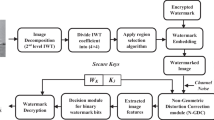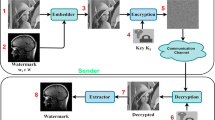Abstract
The hierarchical B picture (HBP) prediction structure is a typical coding scheme used for multiview video coding (MVC). This paper proposes a fragile watermarking algorithm for HBP-based multiview video coding. B_DIRECT_16 × 16 and B_SKIP are two types of macroblocks used for H.264/AVC coding, and are respectively generated in the DIRECT and SKIP prediction modes. Modification of the syntactic elements enables the watermark to be embedded while the B_SKIP macroblock is converted into the B_DIRECT_16 × 16 macroblock. To authenticate the integrity of the multiview video content, the watermark is generated from the content-based features of the cross-view of the multiview video bitstream. Experimental implementation revealed that the structural similarity index (SSIM) of the video quality was not affected by the proposed watermarking scheme. Compared to current algorithms, the proposed algorithm has a higher embedding capacity, produces less bitrate increase, and is less complex. It satisfies the transparency, bitrate stability, fragility, and real-time performance requirements of multiview video authentication.

















Similar content being viewed by others
References
Al-Haj A, Farfoura ME, Mohammad A (2017) Transform-based watermarking of 3D depth-image-based-rendering images. Measurement 95:405–417
Ekmekcioglu E, Gurler CG, Kondoz A, Tekalp AM (2016) Adaptive Multi-View Video Delivery using Hybrid Networking. IEEE Transactions on Circuits and Systems for Video Technology PP:1–1
Fang L, Li S, Kang X, Izatt JA, Farsiu S (2015) 3-D Adaptive Sparsity Based Image Compression With Applications to Optical Coherence Tomography. IEEE Trans Med Imaging 34:1306–1320
H.264/AVC Reference JM Software 18.5. Available: http://iphome.hhi.de/suehring/tml/download/
ITU-T and ISO/IEC JTC 1 (2010) Advanced video coding for generic audiovisual services, ITU-T Recommendation H.264 and ISO/IEC 14496–10 (MPEG-4 AVC)
Jooyoung L, Sung-Hoon K, Se Yoon J, Jin Soo C, Dong-Wook K, Kyeong-Hoon J et al (2015) A Stereoscopic 3-D Broadcasting System Using Fixed and Mobile Hybrid Delivery and the Quality Assessment of the Mixed Resolution Stereoscopic Video. Broadcasting, IEEE Transactions on 61:222–237
Liu Y, Zheng Y, Liang Y, Liu S, Rosenblum DS (2016) Urban water quality prediction based on multi-task multi-view learning. In: Proceedings of the 25th International Joint Conference on Artificial Intelligence (IJCAI 2016), 2576–2582
Liu Y, Zhang L, Nie L, Yan Y, Rosenblum DS (2016) Fortune Teller: Predicting Your Career Path. In: Proceedings of the 30th AAAI Conference on Artificial Intelligence (AAAI 2016), pp. 201–207
Ma X, Li Z, Tu H, Zhang B (2010) A data hiding algorithm for H. 264/AVC video streams without intra-frame distortion drift. Circuits and Systems for Video Technology, IEEE Transactions 20:1320–1330
Mansouri A, Aznaveh AM, Torkamani-Azar F, Kurugollu F (2010) A Low Complexity Video Watermarking in H.264 Compressed Domain. IEEE Transactions on Information Forensics and Security 5:649–657
Mobasseri BG, Berger IRJ, Marcinak MP, NaikRaikar YJ (2010) Data Embedding in JPEG Bitstream by Code Mapping. IEEE Trans Image Process 19:958–966
Moorthy AK, Su C-C, Mittal A, Bovik AC (2013) Subjective evaluation of stereoscopic image quality. Signal Process Image Commun 28:870–883
Multiview video sequences (Akko & Kayo) at Nagoya University. http://www.fujii.nuee.nagoya-u.ac.jp/multiview-data
Multiview video sequences (Ballroom, Exit, and Vassar) at MERL. Available: ftp://ftp.merl.com/pub/avetro/mvc-testseq
Multiview video sequences (Flamenco, Crowd, Race, and Object) at KDDI. Available: ftp://ftp.ne.jp/KDDI/multiview
Park S, Kim B, Kim D-W, Seo Y (2015) Digital Watermarking Algorithm for Multiview Images Generated by Three-Dimensional Warping. Journal of Information and Communication Convergence Engineering 13:62–68
Pröfrock D, Richter H, Schlauweg M, Müller E (2005) H. 264/AVC video authentication using skipped macroblocks for an erasable watermark. Visual Communications and Image Processing 2005:59604C–596010C
Shafai WE, Rabaie SE, Halawany MME, Abd FE, Samie E (2018) Efficient hybrid watermarking schemes for robust and secure 3D- MVC communication. Int J Commun Syst 31:1–23
Son J-Y, Son W-H, Kim S-K, Lee K-H, Javidi B (2013) Three-dimensional imaging for creating real-world-like environments. Proc IEEE 101:190–205
Song G, Li Z, Zhao J, Hu J, Tu H (2013) A reversible video steganography algorithm for MVC based on motion vector. Multimedia Tools and Applications:1–24
Song G, Li Z, Zhao J, Zou M (2014) A Data Hiding Algorithm for 3D Videos Based on Inter-MBs. In: Intelligent Computing Theory. Springer, pp. 541–552
Stütz T, Autrusseau F, Uhl A (2014) Non-Blind Structure-Preserving Substitution Watermarking of H.264/CAVLC Inter-Frames. IEEE Transactions on Multimedia 16:1337–1349
Su P-C, Wu C-S, Chen F, Wu C-Y, Wu Y-C (2011) A practical design of digital video watermarking in H. 264/AVC for content authentication. Signal Process Image Commun 26:413–426
Tew Y, Wong K (2014) An overview of information hiding in H. 264/AVC compressed video. IEEE Transactions on Circuits and Systems for Video Technology 24:305–319
Tian L, Zheng N, Xue J, Li C (2015) Authentication and copyright protection watermarking scheme for H. 264 based on visual saliency and secret sharing. Multimedia Tools and Applications 74:2991–3011
Vetro A, Wiegand T, Sullivan GJ (2011) Overview of the stereo and multiview video coding extensions of the H. 264/MPEG-4 AVC standard. Proc IEEE 99:626–642
Wang C (2015) Robust Digital Watermarking Scheme of Anaglyphic 3D for RGB Color Images. International Journal of Image Processing (IJIP) 9:156–165
Wang S, Cui C, Niu X (2014) Watermarking for DIBR 3D images based on SIFT feature points. Measurement 48:54–62
Wang C-C, Hsu Y-C (2008) Fragile watermarking for H. 264 video stream authentication. In: Intelligent Systems Design and Applications, 2008. ISDA'08. Eighth International Conference on, pp 77–80
Wang C-C, Hsu Y-C (2010) Fragile watermarking scheme for H. 264 video authentication. Opt Eng 49:027003–027009
Wang R, Li Q, Zhu H, Xu D (2012) Fragile watermarking scheme suitable for the authentication of H. 264/AVC video content. Journal of Information & Computational Science 9:3693–3706
Wenfeng L, Gangyi J, Ting L (2015) A Watermarking Algorithm for 3D Videos Stream Based on Spatiotemporal Correlation. In: International Conference on Intelligent Systems Research and Mechatronics Engineering (ISRME 2015), pp. 680–688
Wiegand T, Sullivan GJ, Bjontegaard G, Luthra A (2003) Overview of the H. 264/AVC video coding standard. IEEE Transactions on Circuits and Systems for Video Technology 13:560–576
Xu D, Wang R (2011) Watermarking in H. 264/AVC compressed domain using Exp-Golomb code words mapping. Opt Eng 50:097402–097411
Xu D, Wang R (2015) Context adaptive binary arithmetic coding-based data hiding in partially encrypted H.264/AVC videos. Journal of Electronic Imaging 24:033028–033028
Xu D, Wang R, Shi YQ (2014) Data Hiding in Encrypted H.264/AVC Video Streams by Codeword Substitution. IEEE Transactions on Information Forensics and Security 9:596–606
Xu D, Wang R, Shi YQ (2016) An improved scheme for data hiding in encrypted H. 264/AVC videos. J Vis Commun Image Represent 36:229–242
Xu D, Wang R, Zhu Y (2018) Tunable data hiding in partially encrypted H.264/AVC videos. J Vis Commun Image Represent 45:34–45
Zhang Y, Kwong S, Jiang G, Wang H (2011) Efficient multi-reference frame selection algorithm for hierarchical B pictures in multiview video coding. Broadcasting, IEEE Transactions 57:15–23
Zhang W, Zhang R, Liu X, Wu C, Niu X (2012) A video watermarking algorithm of H. 264/AVC for content authentication. Journal of Networks 7:1150–1154
Zhao J, Li Z (2018) Three-dimensional histogram shifting for reversible data hiding. Multimedia Systems 24:95–109
Zhaoqing P, Yun Z, Sam K (2015) Efficient Motion and Disparity Estimation Optimization for Low Complexity Multiview Video Coding. Broadcasting, IEEE Transactions 61:166–176
Zhou Y, Jiang G, Yu M, Peng Z, Shao F (2012) Region-based error concealment of right-view frames for stereoscopic video transmission. Comput Electr Eng 38:217–230
Zou D, Bloom J (2008) H. 264/AVC stream replacement technique for video watermarking. In: Proceedings of the 2008 IEEE International Conference on Acoustics, Speech and Signal Processing (ICASSP 2008), pp. 1749–1752
Acknowledgements
This work was supported by the Natural Science Foundation of China under Grant nos. 61671258, 61871247, 61671412, and 61501270, the National High-tech R&D Program of China under Grant no. 2015AA015901, the Natural Science Foundation of Zhejiang Province under Grant no. LY15F010005, the Natural Science Foundation of Ningbo under Grant No. 2017A610127. It is also sponsored by K.C. Wong Magna Fund in Ningbo University.
Author information
Authors and Affiliations
Corresponding author
Additional information
Publisher’s Note
Springer Nature remains neutral with regard to jurisdictional claims in published maps and institutional affiliations.
Rights and permissions
About this article
Cite this article
Gao, W., Jiang, G., Yu, M. et al. Lossless fragile watermarking algorithm in compressed domain for multiview video coding. Multimed Tools Appl 78, 9737–9762 (2019). https://doi.org/10.1007/s11042-018-6538-8
Received:
Revised:
Accepted:
Published:
Issue Date:
DOI: https://doi.org/10.1007/s11042-018-6538-8




